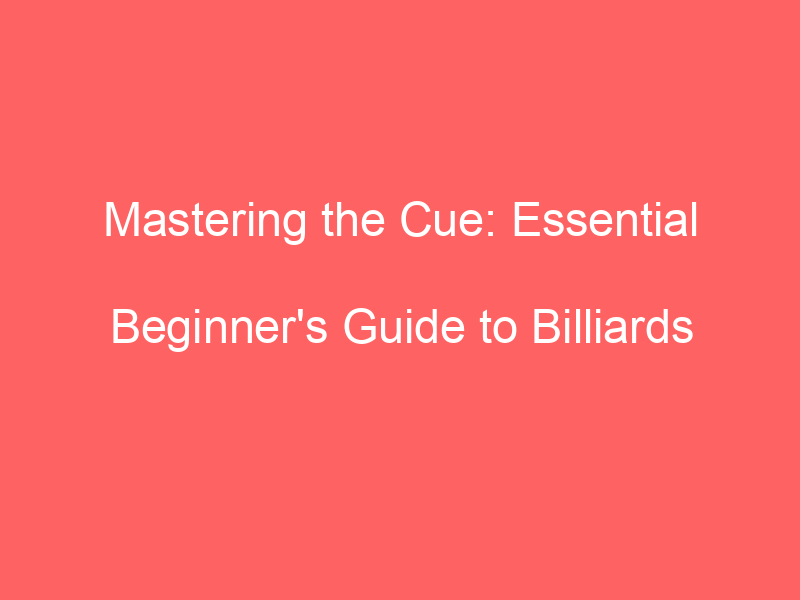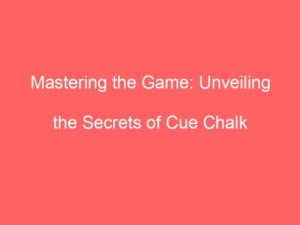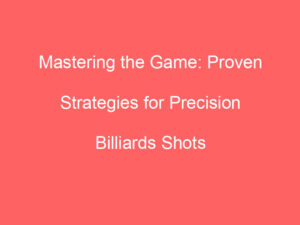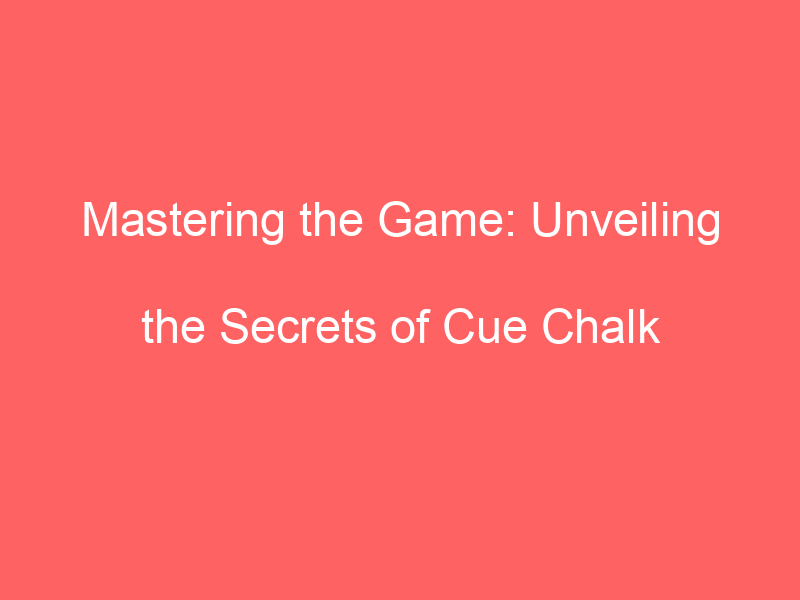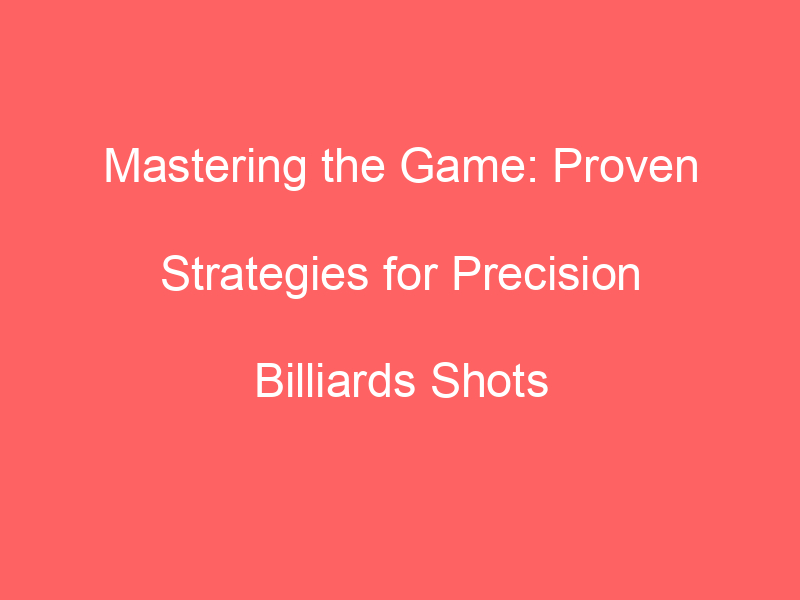
Introduction to Billiards
Welcome to the fascinating world of billiards! This game, which requires both skill and strategy, has been enjoyed by people all over the world for centuries. In this article, we will explore the basics of the game, delve into its rich history, and emphasize the importance of mastering the basics. So, let’s get started!
-
- Understanding the Game
Billiards, also known as pool, is a game played on a rectangular table where the objective is to sink balls into one of the table’s six pockets. The game begins with the balls arranged in a triangle at one end of the table. The player uses a cue stick to strike the cue ball, which then hits the other balls. The game requires a good understanding of angles and precision, making it a perfect blend of physics and fun.
-
- History of Billiards
The game of billiards has a long and colorful history. It originated in the 15th century in Northern Europe and was initially played on a lawn, much like croquet. The game eventually moved indoors and was played on a table covered with green cloth to simulate grass. Over the centuries, the game evolved and gained popularity, becoming a beloved pastime in pubs and parlors worldwide.
-
- Importance of Mastering the Basics
Like any sport or game, mastering the basics in billiards is crucial. Understanding the rules, learning how to properly hold the cue, and practicing basic shots are all essential steps in becoming a proficient player. By mastering the basics, you can develop a solid foundation that will allow you to improve your game and eventually learn more advanced techniques.
Whether you’re a beginner just starting out or an experienced player looking to improve your game, understanding the basics and history of billiards can enhance your appreciation for this timeless game. So grab your cue stick and let’s dive deeper into the world of billiards!
Billiards 101: The Basics
Billiards is a classic game that requires both strategy and skill. To play effectively, you need to understand the basic equipment used in the game. Let’s delve into the essentials of billiards equipment.
Billiards Equipment
Billiards equipment is the backbone of the game. It includes the billiards table, cues, and balls. Each piece of equipment plays a significant role in the game.
-
- Understanding the billiards table
The billiards table is where all the action happens. It’s usually rectangular, covered with a smooth cloth, and surrounded by rubber cushions. The table is divided into six pockets – one at each corner and two in the middle of the long sides. The size of a standard billiards table is 9 feet by 4.5 feet. However, smaller tables are also used, especially in homes and pubs.
-
- Types of cues
Cues are the sticks used to strike the balls. They are typically made of wood, but sometimes graphite or fiberglass is used. There are two main types of cues: one-piece cues and two-piece cues. One-piece cues are usually found in billiards halls and are made from a single piece of wood. Two-piece cues can be separated into two parts for easy transport. They are often used by more serious players who prefer to bring their own cues to games.
-
- Billiards balls and their significance
Billiards balls are the objects that players strike with the cue. In a standard game, there are 15 object balls and one cue ball. The object balls are numbered from 1 to 15 and are divided into two groups: solid-colored balls (numbers 1-7) and striped balls (numbers 9-15). The 8-ball is black. The cue ball is white and is the only ball that players are allowed to hit directly with the cue. Each ball plays a unique role in the game, and understanding their significance can help improve your strategy.
Understanding the equipment is the first step to mastering billiards. In the next section, we will cover the basic rules of the game.
Basic Billiards Rules for Beginners
Billiards is a game of strategy and skill. To play it well, you need to understand its basic rules. Here are the three fundamental rules every beginner should know:
-
- Setting up the game
Setting up a game of billiards is quite simple. First, you need to arrange the billiard balls in a triangle at one end of the table. The apex ball is placed on one of the two spots on the table. The arrangement of the rest of the balls can vary, but typically, the 8-ball goes in the center of the triangle. Once the balls are set, the first player breaks the triangle of balls using the cue ball.
-
- Understanding fouls
In billiards, a foul can occur in several ways. For example, if a player fails to hit any ball with the cue ball, it’s a foul. Another common foul is when the cue ball is knocked into a pocket. When a foul occurs, the opposing player gets a chance to place the cue ball anywhere on the table for their shot. Remember, committing a foul could give your opponent an advantage, so it’s crucial to avoid them.
-
- Scoring in billiards
Scoring in billiards can seem complicated at first, but it’s actually straightforward. In most games, players score points by pocketing balls. Each ball pocketed is worth one point, and the player who pockets more balls wins the game. However, in some variations of billiards, the scoring rules can be different. For example, in 8-ball, the player who pockets the 8-ball after all their group of balls wins the game.
Understanding these basic rules will help you get started with billiards. However, remember that the best way to improve is by practicing regularly. So, grab a cue and start playing!
Essential Billiards Tips for Beginners
Billiards is a game of precision and strategy. For beginners, it can seem daunting, but with the right techniques, you can quickly improve your game. Here are some essential tips to get you started.
Billiards Techniques for Beginners
Mastering the basics is the first step towards becoming a proficient billiards player. Here are three fundamental techniques that every beginner should know:
- How to hold the cue: Holding the cue correctly is the foundation of a good shot. Your grip should be firm but relaxed, with your index finger and thumb forming a circle around the cue. The cue should rest on the base of your thumb, and your other fingers should lightly touch the cue. Your forearm should be perpendicular to the floor when you’re about to strike the ball.
- Perfecting your aim: Aiming is crucial in billiards. To perfect your aim, you need to visualize the path of the ball. Start by aligning your cue with the ball and the pocket you want to hit. Practice this technique until you can consistently hit the ball where you aim.
- Mastering the break shot: The break shot is the first shot of the game and can set the tone for the rest of the match. To master the break shot, you need to strike the cue ball with power and precision. Aim for the center of the front ball in the rack, and try to spread the balls as widely as possible.
Remember, practice makes perfect. Don’t be discouraged if you don’t master these techniques immediately. Keep practicing, and you’ll see improvement over time.
Billiards Strategy for Beginners
As a beginner, understanding and implementing strategies in your billiards game can significantly improve your performance. Here are three fundamental strategies to consider:
- Planning Your Shots
Planning your shots is a crucial part of billiards strategy. It involves thinking ahead about where the cue ball will land after it hits your target ball. This strategy allows you to set up your next shot, making it easier to pocket multiple balls in succession. For instance, if you’re aiming at the 8-ball, consider where the cue ball will end up after the shot. Will it be in a good position for your next shot? If not, adjust your aim or power accordingly.
- Defensive Play
Defensive play, also known as “safety play,” is another essential strategy in billiards. This involves making a shot that not only keeps you in the game but also makes it difficult for your opponent to make their next shot. For example, you might hit the cue ball lightly so that it ends up behind another ball, blocking your opponent’s shot. This strategy can be a game-changer, especially when used at the right time.
- Understanding Ball Control
Understanding ball control is all about mastering the physics of billiards. It involves knowing how much force to apply to the cue ball, the angle to hit the ball, and how to use spin (also known as “English”) to control the ball’s direction after impact. For example, hitting the ball on its right side will cause it to spin to the left after hitting your target ball. This strategy requires practice, but once mastered, it can greatly enhance your game.
In conclusion, planning your shots, playing defensively, and understanding ball control are three key strategies for beginners in billiards. By incorporating these strategies into your game, you can improve your performance and enjoy the game more. Remember, practice makes perfect, so keep playing and learning!
Learning Billiards: Practice Drills
Now that we’ve covered the basics of billiards, it’s time to dive into some practical exercises. These drills are designed to help you improve your game by focusing on three key areas: aim, cue control, and the break shot. Remember, practice makes perfect, so let’s get started!
-
Drills for Improving Aim
Improving your aim is crucial for a successful game of billiards. Here are a few drills to help you:
- The Line Drill: Line up five balls in a straight line and try to pocket each one without disturbing the others. This will help you focus on accuracy.
- The Circle Drill: Arrange the balls in a circle and aim for the center. This drill will improve your ability to hit targets from different angles.
-
Drills for Mastering Cue Control
Cue control is all about how you handle the cue stick. Here are a couple of drills to help you master this skill:
- The Follow Drill: Hit the cue ball so that it follows the object ball after contact. This will help you understand how to control the cue ball’s direction.
- The Draw Drill: Try to make the cue ball come back towards you after hitting the object ball. This will improve your backspin control.
-
Drills for Perfecting the Break Shot
The break shot is the first shot of the game, and it can set the tone for the rest of the match. Here are some drills to help you perfect it:
- The Power Break Drill: Practice hitting the cue ball with as much force as you can. This will help you develop a powerful break shot.
- The Control Break Drill: Try to control where the cue ball ends up after the break. This will help you maintain control of the table after the break shot.
Remember, the key to improving your billiards game is consistent practice. These drills are designed to help you develop your skills, but it’s up to you to put in the time and effort. Happy practicing!
Common Mistakes Beginners Make
As a beginner in the world of billiards, it’s natural to make a few mistakes along the way. However, understanding these common pitfalls can help you improve your game faster. Let’s take a look at some common mistakes that beginners often make:
- Overcomplicating shots: Many beginners tend to overthink their shots, leading to unnecessary complications. It’s important to remember that billiards is a game of strategy and precision, not complexity. Instead of trying to make a fancy shot, focus on hitting the ball accurately and strategically. For example, instead of attempting a difficult bank shot, a simple straight shot might be more effective.
- Ignoring defensive play: Another common mistake is focusing too much on offense and ignoring defensive play. In billiards, defense is just as important as offense. If you can’t make a shot, try to leave the cue ball in a position that makes it difficult for your opponent to make their shot. This strategy can often turn the tide of the game in your favor.
- Not practicing enough: Practice makes perfect, and this is especially true in billiards. Many beginners don’t spend enough time practicing their shots, leading to inconsistent performance. It’s important to set aside time each week to practice your shots and improve your skills. Remember, even the best players in the world spend hours each day practicing.
In conclusion, avoiding these common mistakes can significantly improve your billiards game. Remember to keep your shots simple, focus on both offense and defense, and practice regularly. With time and dedication, you’ll see your skills improve and your enjoyment of the game increase.
Conclusion: The Journey to Mastering Billiards
As we reach the end of this informative journey, it’s important to remember that mastering billiards is a process that requires patience, dedication, and consistent practice. Let’s recap some of the essential tips and insights we’ve discussed.
- Recap of essential tips: We’ve covered a wide range of tips, from understanding the basics of billiards to avoiding common mistakes beginners make. Remember, the key to a good shot lies in the grip, stance, and aim. Always aim for the center of the cue ball to avoid unnecessary spins. And most importantly, stay calm and focused during your game.
- Importance of consistent practice: Billiards is a game of skill and precision, and these are honed through consistent practice. The more you play, the better you’ll get. Make it a point to practice regularly, even if it’s just for a few minutes each day. Over time, you’ll notice improvements in your game.
- Encouragement for the learning journey: Learning billiards can be challenging, but don’t let that discourage you. Everyone starts somewhere, and every expert was once a beginner. Keep practicing, stay patient, and most importantly, enjoy the game. Remember, the journey to mastering billiards is a marathon, not a sprint.
In conclusion, mastering billiards is a journey filled with learning, practice, and continuous improvement. It’s not just about winning games, but also about enjoying the process and the personal growth that comes with it. So, pick up your cue stick, aim for the ball, and embark on your journey to becoming a billiards master. Good luck!

